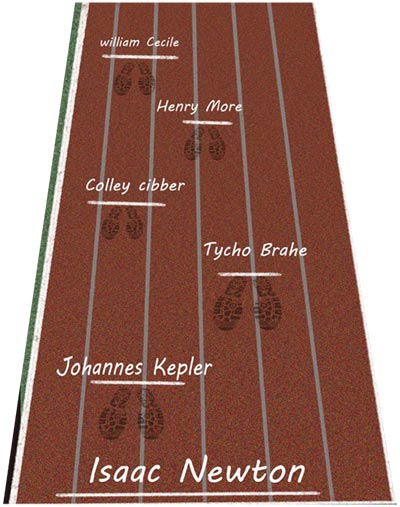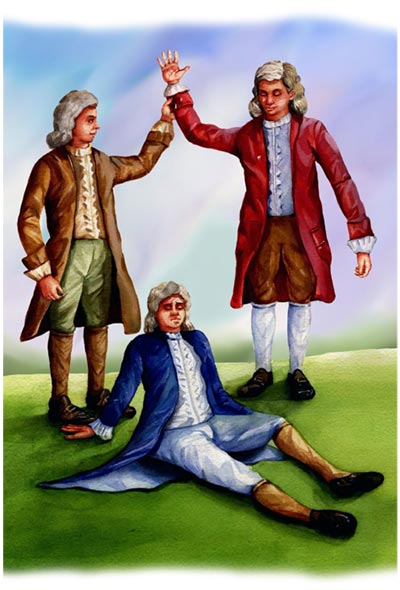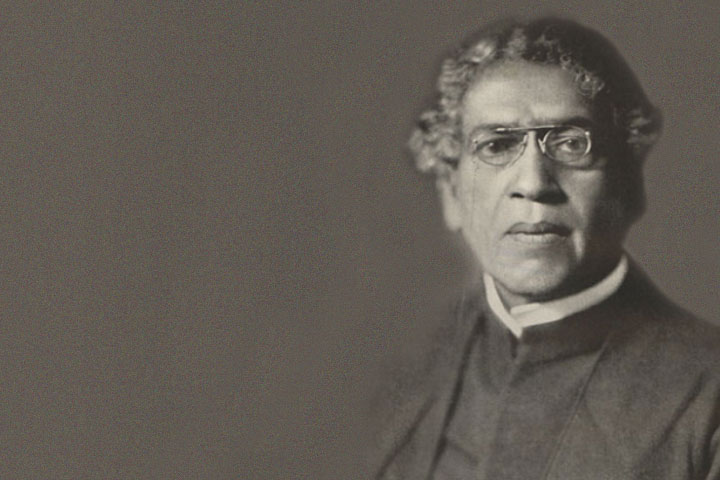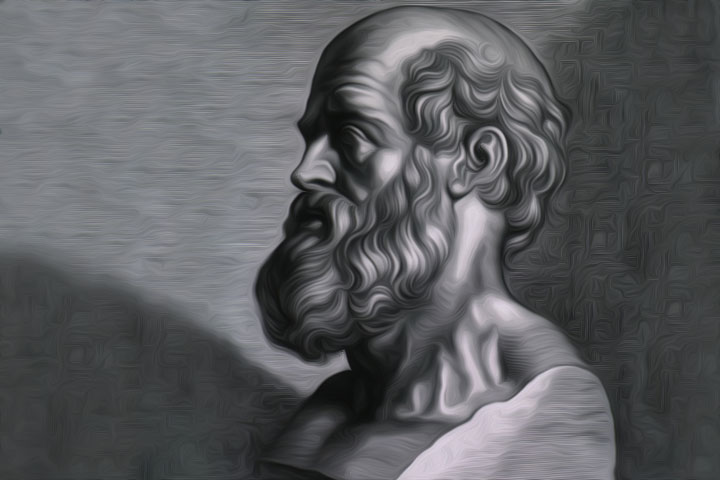
Sir Isaac Newton, the most influential scientist of the world was a respected polymath. He was a physicist, a mathematician, an astronomer, natural philosopher, an alchemist and a theologian. Today’s modern and technically advanced era of scientific supremacy could not be possible without his scientific and mechanical contributions. His discoveries in various fields are a priceless gift to mankind. Sir Isaac Newton was an extraordinary genius, who advanced every branch of Mathematics and Physics. His discoveries and works laid the foundation of modern classical mechanics which dominated the scientific view of the physical universe for the next three centuries. He certainly is the key person of modern scientific revolution. But, as a person, he had shown a very complex character throughout his life.
Whereas at one end, Newton was extremely focused and deeply concentrated at his works and experiments; on the other, he was a very lonely person struggling against his emotionally scattered childhood that was full of resentments. Throughout his life, he verged on the brink of an emotional collapse, occasionally falling into violent and vindictive attacks against friend and foe alike.
Newton, although an unorthodox Christian, was deeply religious and always feared being accused of refusing holy orders. Newton’s journey of life oscillated between the peaks of the realizations of the truth of universe and the crests of some negative feelings, like hatred towards women, volatile temper, fear, resentments and many other emotional complexities. The seed of his complex character lies in his lonesome and distraught childhood. It seems that the sorrow and solitude culminated inside the child Newton was transformed into the great affection and inquisition for Mother Nature in due course. Mother Nature also lovingly opened her secrets to her dear child, Newton.
A versatile scientist, a creative genius, a sensitive human being, a strict administrator and a meditative holy person; Newton’s journey of life begins with a sad and lonely childhood.

A Devastated Childhood
According to the old calendar used in those days in England, Isaac Newton was born in the manor house of Woolsthorpe, near Grantham in Lincolnshire, England on the Christmas Day of 1642. Later, his date of birth was corrected according to the Gregorian calendar as 4th January, 1643. His father, also named as Isaac Newton, was a prosperous illiterate farmer who could not even sign his own name. He died in October 1642, three months before his son was born. As a prematurely born baby, Newton was a small child. His mother Hannah Ayscough reportedly said that he could have fit inside a quart mug (≈1.1litres). In January 1646, just after Newton’s third birthday, his mother remarried Barnabas Smith, the Minister of the Church at North Witham, in a nearby village. She went to live with her new husband leaving her child in the care of his maternal grandmother, Margery Ayscough, at Woolsthorpe.
The devastated child, who had never set eyes on his father, was now suddenly parted from his mother too. As he grew older, he discovered how agonizingly close his mother remained; by climbing a tree he could view the steeple of North Witham’s church in the distance. That is where she was living. But he was aware of the bitter fact that there was a mysterious stranger who had ‘stolen’ his mother away. An emotionally shattered Newton always thought of himself as an orphan. Abandoned with the maternal love and care, he never found emotional support and attachment with his grandparents. His grandfather, James Ayscough was never mentioned by Newton in later life and James too, left nothing to Newton in his will. James had made his will when Newton was 10 years old. Maybe, this was one of the reasons of resentment inculcated inside Newton with respect to his grandfather.
When Newton’s stepfather died in 1653, Hanna, now a very rich widow, returned to Woolsthorpe with the three children in tow. For more than eight years, Newton was effectively separated from his mother. His pronounced psychotic tendencies have been ascribed to this traumatic event. He developed an acute sense of insecurity that rendered him an obsessively anxious person. Now, Newton lived in an extended family consisting of his mother, his grandmother, one half-brother and two half-sisters. By this time, 11 year old Newton had long since learnt to insulate himself from human contact by withdrawing into the hidden recesses of his mind. His brother and sisters were never mentioned by Newton in his later life. It seems, he did not have any friendly or formal rapport with his family members. It is clear that the abandoned son not only possessed a volatile temper, but also nursed grudges and would wait years, if need be, to gain revenge on those he believed had wronged him.

The young Newton disliked his stepfather and maintained some enmity towards his mother for marrying him, as revealed by the entries in a list of sins committed up to the age of 19:
“Threatening my father and mother Smith to burn them and the house over them.”
“Wishing death and hoping it to some.”
Cambridge psychologist Simon Baron-Cohen considered it fairly certain that Newton had ‘Asperger’ syndrome. People with Asperger syndrome often have difficulty socially but many of them have above-average intelligence. They may excel in fields such as computer programming and science. There is no delay in their cognitive development, ability to take care of themselves, or curiosity about their environment. People with Asperger syndrome become over-focused or obsessed on a single object or topic, ignoring all others. They want to know everything about this subject and often talk about little else. Their problems with speech and language in a social setting often lead to isolation and aloofness.

Early Schooling
Hannah was determined that Newton, unlike his father, should grow up literate. During her absence, Newton was enrolled in a village school to which he walked back and forth each day. A year after Hannah returned to Woolsthorpe, the 12 year old Newton began attending the Free Grammar School called King’s School at Grantham. Although the market town Grantham was only five miles from his home, Newton lodged with William Clarke’s family at Grantham. It seems Newton’s indifferent behaviour with the family members was the reason behind his lodging with William Clarke’s family at Grantham.
At King’s School, Latin and Greek were the languages of instruction, and during this period the foundations of young Newton’s classical education were laid. Bible studies were also an important part of the curriculum. Newton became familiar with the Hebrew script also. Though grammar and literature were the main focus of the school curriculum, students also received a limited amount of instruction in arithmetic. It is reported that instead of playing with the other boys after school, Newton ‘ busied himself in making knickknacks and wood models in many kinds; for which purpose he had got little saws, hatches, hammers and a whole shop of tools, which he would use with great dexterity.’
Some of his frequently mentioned mechanical models were his windmill model, Newton’s dial (as was popularly known) to know the time, water clock etc. Water clock was constructed from a wooden box given to him by William Clarke’s brother-in-law. It stood four feet high and had a dial at the top with the numbers of the hours. The device was driven by a piece of wood, which alternately rose and fell according to the rhythmic dripping of water. It was kept in the room where he lived and was occasionally checked by the Clarkes to see what hour it was.
Newton was equally fascinated by kites and made them in various shapes to determine the design best suited for a sustained flight. He also made lanterns from crumpled paper and lit them with candles while walking to school on dark winter mornings. These he sometimes tied to the tails of his kites at night, frightening the country people who mistook them for passing comets. Isaac Newton was not simply an aimless childhood tinkerer, but a tinkerer playing with ideas and mechanism.
An interesting incident took place when the Lord protector Oliver Cromwell died in September 1658. A great storm swept over England, giving rise to the superstition that it was the devil riding the whirlwind to claim his lost soul. Taking advantage of a rare opportunity of this great storm, 15 year old Newton entered into a competition with several of the more athletic youths to see who could jump the farthest. By carefully timing the gusts of wind, he out-leaped the other boys, much to their surprise and embarrassment. Many years later, Newton remarked to a relative that this was one of his first experiments.
According to Dr. William Stukeley, a friend of Isaac Newton, “smaller and physically weaker than most of his schoolmates, Newton attempted to teach them ‘to play philosophically’.” As a teenager, Newton had interest in sketching and poetry also but these were passed soon. He had interest in books too. One of the many books that captured his attention was ‘the Mysteries of Nature and Art’ by John Bate, the third edition of which was published in 1654, when Newton was 11.
In light of his interest in books and all things mechanical, one would have expected Newton to do well in his studies, but that was not the case. His school reports described him as 'idle' and 'inattentive'. He was motivated to study partly by a desire for revenge against a schoolyard bully. One day in the school, a physical fight took place between Newton and one of his class-mate, who was physically stronger and better in studies than him. Though Newton was weaker, he fought revengefully and ultimately defeated him. It is reported that this incident proved as a turning point for Newton. He started paying attention to his studies and soon became the top-ranked and a star student of the school. These school years were the happiest in Newton’s life, but his mother Hannah had decided that he must return to Woolsthorpe to begin learning ways of a respected landowner. She thought that her eldest son was the right person to manage her affairs and her estate. Hannah was adamant. Newton was taken away from school, but soon showed that he had no talent or interest in managing an estate. Dr. William Stukeley recalled, “His chief delight was to sit under a tree, with a book in his hands, or to busy himself with his knife in cutting wood for models of something or other that struck his fancy, or he would go to a running stream, and make little millwheels to put into the water.” Not only did the sheep stray and the wheat go unplanted, but the adolescent often forgot to return home for meals, a character trait that would resurface in the adult Newton. Related to his passion for learning one of the sin listed by Newton was:-
...setting my heart on money, learning, and pleasure more than Thee...
This clearly tells us how passionate Newton was about learning.
On the other hand, all the endeavours of an annoyed Hannah to change Newton’s behaviour went into vain and Newton continued to live for the creation of his own mind.

Impressed by the models and devices made by Newton and his urge for knowledge, Henry Stokes, the headmaster of King’s School, who was keeping close track of his star pupil, finally decided to intercede on Newton’s behalf. According to him, “The only way whereby he could preserve or raise his fortune must be by fitting him for the university.” Henry Stokes had a firm belief over the extraordinary possibilities inside Newton. He visited Hannah at Woolsthorpe and tried to make her understand. The headmaster even offered to forego forty shillings required of all pupils born more than a mile from Grantham, no small sacrifice for a man of modest means. To an illiterate woman, land was the only thing that mattered, which she owned now after her two marriages. She was unable to understand Newton as a person and the need and importance of higher studies for him. She finally turned to her trusted brother, William Ayscough for advice. To her surprise, William also advised her that Newton should return to school and therefore, a reluctant Hannah gave her consent.
At the age of 17, Newton returned to the King’s School in Grantham in 1660 to complete his school education. This time, he lodged with Henry Stokes, the headmaster of the school. It seems Henry Stokes was the person who shaped Newton’s intellect in its initial stage to be a future scientist. Finally, in 1661, an 18 year old Newton completed his school education.
At the moment of departure, with tears in his eyes, Henry Stokes made a speech praising the young man and urging the other youths to follow his example. On a window ledge of King’s School, with the aid of a penknife, Newton left a simple, permanent record to be gazed upon by later generation of curious admirers: “I. Newton.”
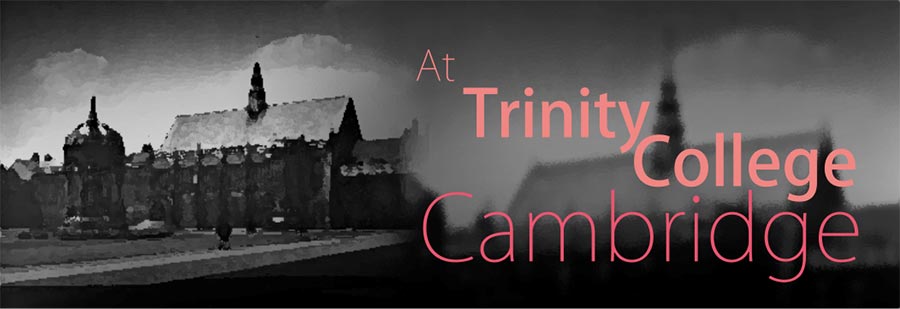
At Trinity College Cambridge
On 5th June, 1661, Newton entered Trinity College, Cambridge. He was older than most of his fellow students but, despite the fact that his mother was financially well off, he entered as a sizar- a sort of work-study role. At Cambridge, a sizar was a student who received an allowance towards college expenses in exchange for acting as a servant to other students. There is certainly some ambiguity in his position as a sizar, for he seems to have associated with 'better class' students rather than other sizars. Some reports suggested that Newton may have had Humphrey Babington, a distant relative who was a Fellow of Trinity, as his patron. This reasonable explanation would fit well with what is known, and also mean that his mother did not subject him unnecessarily to hardship, as some of his biographers claim.
It is reported, that initially Newton's aim at Cambridge was a law degree. At that time, the college's teachings were based on those of Aristotle (Greek philosopher and polymath), whom Newton supplemented with modern philosophers such as Descartes, Gassendi, Hobbs and in particular Boyle and astronomers such as Copernicus, Galileo and Kepler. He recorded his thoughts in a book which he entitled ‘Quaestiones Quaedam Philosophicae’ (Certain Philosophical Questions).
It is clear that Newton was yet far away from the interest or the studies of Mathematical Sciences. How he got introduced to the most advanced mathematical texts of his day is also ambiguous. According to the famous mathematician Abraham de Moivre, Newton's interest in mathematics began in the autumn of 1663 when he bought an astrology book (astrological science happens to be pure mathematical in its content) at a fair in Cambridge and found that he could not understand the mathematics in it. Again attempting to read a trigonometry book, he found that he lacked knowledge of geometry and so he decided to read the famous mathematician Barrow's edition of Euclid's “Elements”, a famous book on mathematics. The first few results were so easy that he almost gave up, but he:
“...Changed his mind when he read that parallelograms upon the same base and between the same parallels are equal.”
After Euclid's Elements, Newton studied many books on mathematics like Oughtred's “Clavis Mathematica”, Descartes “La Géométrie” and “Analytical Geometry” by Viète. Newton also studied Wallis’s “Algebra” and read his method for finding a square of equal area to a parabola and a hyperbola which used indivisibles. Newton’s first original mathematical work was derived from this study. Not only did Newton make notes of Walli’s treatment but also devised his own facts of the theorems writing:
“Thus Wallis doth it, but it may be done thus...”
There is no evidence or any mention of a guiding hand for Newton. It leads to the belief that Newton alone was responsible for his mathematical education.
Newton's talent began to emerge on the arrival of Barrow to the Lucasian Chair at Cambridge in 1663. The incumbent of the Lucasian Chair of Mathematics, usually called the Lucasian Professor, is the holder of a mathematics professorship at the University of Cambridge, England. It is widely regarded as one of the world's most prestigious academic posts. It was founded by Henry Lucas, Cambridge University’s Member of Parliament from 1639-1640. The post was officially established by King Charles II on January 18, 1664. It is a fascinating account of how Newton's ideas were already forming around 1664. He headed the text with a Latin statement meaning “Plato is my friend, Aristotle is my friend, but my best friend is truth”, showing himself a free thinker from an early stage.
In 1664, Newton became a Fellow at Trinity College. Certainly the date matches the beginnings of Newton's deep mathematical studies. Despite some evidence that his progress had not been particularly good, Newton was elected a scholar on 28th April, 1664, after passing the required scholarship examinations. Promoted from the title of 'sizar' to a 'scholar', he was now entitled to receive free meals from his college in addition to a regular stipend. More importantly, he could remain at Trinity to take his master's degree. And finally, at the age of 22, Newton received his Bachelor's degree in the spring of 1665.
In the summer of 1665 Newton had to return to his home in Woolsthorpe, Lincolnshire as the university temporarily closed as a precaution against the Great Plague. At Lincolnshire, in a period of less than two years, he began revolutionary advances in Mathematics, Optics, Physics and Astronomy.
While Newton remained at home in those so called plague years (1665-67), he laid the foundations for differential and integral calculus, several years before its independent discovery by Leibniz, the famous German mathematician. Newton termed it as the 'method of fluxions'. It was based on his crucial insight that the integration of a function is merely the inverse procedure to differentiating it. Taking differentiation as the basic operation, Newton produced simple analytical methods that unified many separate techniques previously developed to solve apparently unrelated problems such as finding areas, tangents, the lengths of curves, and the maxima and minima of functions. He also discovered the generalized binomial theorem and began to develop a mathematical theory that later became infinitesimal calculus, optics and the law of gravitation.
During this period, Newton experienced the insight that has since become a legend. About this period, decades later, he wrote to the French scholar Pierre Des Maizeaux, “For in those days I was in the prime of my age of invention and minded mathematics and philosophy more than at any time since.”
In 1667, he returned to Cambridge as a minor Fellow of Trinity. Fellows were required to become ordained priests (Ordination is the process by which individuals are consecrated, i.e., made to associate with the sacred and set apart as clergy to perform various religious rites and ceremonies), something Newton desired to avoid due to his unorthodox views. Luckily for Newton, there was no specific deadline for ordination, and it could be postponed indefinitely. However, the problem became more severe later in 1669, when Newton was elected for the prestigious Lucasian Chair.
Just after being awarded his master's degree, at the age of 25, Newton was elected for a major fellowship in July 1668 which allowed him to dine at the Fellows' Table. In July 1669, Barrow, who was the Lucasian Professor at Cambridge since 1663, tried to ensure that Newton's mathematical achievements became known to the world. He sent Newton's text ‘De Analysi’ to John Collins, an English mathematician in London, writing:
[Newton] “brought me the other day some papers, wherein he set down methods of calculating the dimensions of magnitudes like that of Mr. Mercator concerning the hyperbola, but very general; as also of resolving equations; which I suppose will please you; and I shall send you them by the next.”
Barrow’s action could lead to quick recognition; hence, Collins corresponded with all the leading mathematicians of the day. Brouncker, the President of the Royal Society was shown Newton’s results by Collins, after which they were returned back on Newton’s request.
Newton's work has been said, "to distinctly advance every branch of mathematics then studied".
His work on the subject usually referred to as fluxions or calculus, seen in a manuscript of October 1666, is now published among Newton's mathematical papers. The author of the manuscript “De analysi per aequationes numero terminorum infinitas”, sent by Barrow to John Collins in June 1669, was identified by Barrow in a letter sent to Collins in August of that year as:
“Mr. Newton, a fellow of our college, very young...but of an extraordinary genius and proficiency in these things.”
Barrowresigned from the Lucasian Chair in 1669 to devote himself to divinity, recommending Newton, still only 27 years old, to be appointed in his place. In those days, any fellow of Cambridge or Oxford was required to become an ordained priest. However, the terms of the Lucasian professorship required that the holder not be active in the church (presumably so as to have more time for science). Newton argued that this should exempt him from the ordination requirement, and Charles II, whose permission was needed, accepted this argument. Thus, a conflict between Newton's religious views and Anglican orthodoxy was averted. Shortly after his appointment as Lucasian Professor
Newton met Collins twice during his visit to London. He later wrote:
“... having no more acquaintance with him I did not think it becoming to urge him to communicate anything.”
Newton's first work as Lucasian Professor was on Optics, also the topic of his first lecture course which began in January 1670. During the two plague years, he had reached to a conclusion that white light is not a simple entity; which was a completely new thought. Before this every scientist since Aristotle had believed that white light was a basic entity. However, when Newton passed a thin beam of sunlight through a glass prism, a spectrum of seven colours was formed, which was duly noted by the great intellectual. The chromatic abbreviation in a telescope lens convinced him otherwise.
Developing over a few years, a series of increasingly elaborate, refined and exact experiments, Newton discovered measurable and mathematical patterns in the phenomenon of colour. He found white light to be a mixture of infinitely varied coloured rays (manifest in the rainbow and the spectrum), with each ray definable by the angle through which it is refracted on entering or leaving a given transparent medium. He correlated this notion with his study of the interference colours of thin films (for example, of oil on water, or soap bubbles), using a simple technique of extreme acuity to measure the thickness of such films.
Newton held the belief that light consisted of streams of minute particles. From his experiments he could infer the magnitudes of the transparent 'corpuscles' forming the surfaces of bodies, which, according to their dimensions, so interacted with white light as to reflect selectively, the different observed colours of those surfaces. He argued that white light was really a mixture of many different types of rays which were refracted at slightly different angles, and that each different type of ray produced a different spectral colour. Newton was led by this reasoning to the erroneous conclusion that telescopes using refracting lenses would always suffer chromatic aberration. He therefore proposed and constructed a reflecting telescope in 1672.
At the age of 29 years, Newton was elected a fellow of the Royal Society (a learned society in UK for sciences) after donating a reflecting telescope. In the same year, Newton published his first scientific paper on light and colour in the 'Philosophical Transactions of the Royal Society'. The paper was generally well received, but Robert Hooke, the society's celebrated curator of experiments, and Huygens, the famous mathematician, objected and criticized it bitterly. Newton could not take it easy and locked horns with Robert Hooke.

In 1675, at the age of 32, Newton ventured yet another paper, which again drew lightning, this time charged with claims that he had plagiarized from Hooke. The charges were entirely ungrounded but a twice burnt Newton, withdrew. The ensuing controversy which continued until 1678, established a pattern in Newton's behaviour. He was always pulled in two directions; there was something in his nature which wanted fame and recognition yet another side of him feared criticism and the easiest way to avoid being criticized was to publish nothing. Although the two men made their peace with an exchange of polite letters, Newton turned in on himself and away from the Royal Society which he associated with Hooke as one of its leaders.
Newton was also engaged in another exchange on his theory of colours with a circle of English Jesuits in Liège, perhaps the most revealing exchange of all. Although their objections were shallow, their contention that his experiments were mistaken lashed him into a fury. The correspondence dragged on until 1678, when a final shriek of rage from Newton, apparently accompanied by a complete nervous breakdown, was followed by silence. The death of his mother the following year completed his isolation.
It is reported that Newton had a very bitter relationship with his mother in later life also. Abandoned with the motherly love and care since childhood, he collected rage and resentment towards women. Maybe this was the reason behind his illogical hatred towards women during his entire life. There is no evidence of love or romance in Newton's life. At most, what can be said is that no evidence has been uncovered which even faintly hints of his being romantically involved with any woman. However, it is also reported that Newton was once engaged, but he never married. This claim was made by Dr. William Stukeley, in 1727, in a letter about Newton written to Dr. Richard Mead, an English physician and a fellow of Royal Society. Charles Hutton, who in the late 18th century collected oral traditions about earlier scientists, declares that there "do not appear to be any sufficient reason for his never marrying, if he had an inclination so to do. It is much more likely that he had a constitutional indifference to the state and even to the sex in general." After his nervous breakdown, for six years Newton withdrew from intellectual commerce except when others initiated a correspondence, which too he always broke off as quickly as possible.
Newton was working on many subjects at the same time. His greatest achievement was his work in Physics and Celestial Mechanics, which culminated in the theory of universal gravitation. Newton had early versions of his world famous 'Three laws of Motion' since 1666. He had discovered the law giving the centrifugal force on a body moving uniformly in a circular path. However, he did not have a correct understanding of the mechanics of circular motion.
Newton was inspired to formulate his theory of gravitation by watching the fall of an apple from a tree. Newton himself told this story many times and it is confirmed by his friend William Stukeley also. Stukeley once visited Newton at his home in Kensington near London. After dining, they went into the garden to drink tea under the shade of some apple trees. Amidst other discourse, Stukeley wrote, “he told me he was just in the same situation as when formerly the notion of gravitation came into his mind. It was occasioned by the fall of an apple, as he sat in a contemplative mood.”

John Conduitt, Newton's assistant at the Royal Mint (the body permitted to manufacture, or mint coins in United Kingdom) and husband of Newton's niece, also described the event when he wrote about Newton's life: “In the year 1666 he retired again from Cambridge to his mother in Lincolnshire. Whilst he was pensively meandering in a garden it came into his thought that the power of gravity (which brought an apple from a tree to the ground) was not limited to a certain distance from Earth, but that this power must extend much further than was usually thought. Why not as high as the Moon said he to himself & if so, that must influence her motion & perhaps retain her in her orbit, whereupon he fell a calculation what would be the effect of that supposition.”
Voltaire, a French enlightenment writer, historian and philosopher also wrote in his essay on ‘Epic Poetry’,
"Sir Isaac Newton walking in his gardens, had the first thought of his system of gravitation, upon seeing an apple falling from a tree."
This was the most excellent idea of Newton, his truly brilliant insight: if the force of gravity reaches to the top of the highest tree, might it not reach even further; in particular, might it not reach all the way to the orbit of the Moon! Then, the orbit of the Moon about the Earth could be a consequence of the gravitational force, because the acceleration due to gravity could change the velocity of the Moon in just such a way that it followed an orbit around the Earth.
This can be illustrated with an experiment: Suppose, a cannon is fired horizontally from a high mountain; the projectile will eventually fall to Earth because of the gravitational force directed toward the centre of the Earth and the associated acceleration. But, if the muzzle velocity is increased for the imaginary cannon, the projectile will travel further and further before returning to Earth.
Finally, Newton reasoned that if the cannon projected the cannon ball with exactly the right velocity, the projectile would travel completely around the Earth, always falling in the gravitational field but never reaching the Earth, which is curving away at the same rate that the projectile falls. That is, the cannon ball would have been put into orbit around the Earth. Newton concluded that the orbit of the Moon was exactly of the same nature: the Moon continuously 'fell' in its path around the Earth because of the acceleration due to gravity, thus producing its orbit.
By such reasoning, Newton came to the conclusion that any two objects in the universe exert gravitational attraction on each other, with the force having a universal form. Newton analyzed the motion of bodies in resisting and non-resisting media under the action of centripetal forces. The results were applied to orbiting bodies, projectiles, pendulums and free-fall near the Earth. He further demonstrated that the planets were attracted towards the Sun by a force varying as the inverse square of the distance, and generalized, that all heavenly bodies mutually attract one another.
Further generalization led Newton to the law of universal gravitation:
“... all matter attracts all other matter with a force proportional to the product of their masses and inversely proportional to the square of the distance between them.”
The word Gravity comes from a Latin word 'gravitas' which means 'heavy'. It can be said that Newton did not exactly 'discover' gravity, but he was the one who gave a new meaning to what heaviness was. The theories defining the same allowed him to depict celestial bodies like planets and moons, as 'exerting gravitational forces on each other, as indicated by their orbital motions.' According to his theories, a planet does not float away from the Sun, simply because there is this imperceptible gravitational force between the planet, the Sun and the Moon that continuously pulls it back. 'Planets and the Sun were, in effect, heavy'.
Thus, Newton's novel idea of 1666 was to imagine that the Earth's gravity influenced the Moon, counter-balancing its centrifugal force. Envisioning the Moon as a giant apple, Newton developed the idea of how gravity works. The satellite's tendency to move away from Earth in a straight line is counteracted by the inward pull of gravity, which produces an orbit, much as an object on a string when it is whirled around one's head. The Moon is perfectly balanced between the tendency to move outward (centrifugal force) and the inward pull of Earth.
From his law of centrifugal force and Kepler's third law of planetary motion, Newton deduced the inverse square law.
In 1679, when Newton was 36 years old, he got in touch with Hooke who had written to Newton claiming:
“...that the Attraction always is in a duplicate proportion to the Distance from the Centre Reciprocal...”
M Nauenberg, Professor of Physics at Cambridge University, writes an account of the next events:
“After his 1679 correspondence with Hooke, Newton, by his own account, found a proof that Kepler's areal law was a consequence of centripetal forces, and he also showed that if the orbital curve is an ellipse under the action of central forces then the radial dependence of the force is Inverse Square with the distance from the centre.”
The physical significance of Kepler's second law was visible in this discovery (sometimes referred to as the law of equal areas, it describes the speed at which any given planet will move while orbiting the Sun).
Meanwhile, Newton's unconventional ideas regarding white light and colours provoked hostile criticism mainly because colours were thought to be modified forms of homogeneous white light. Doubts and Newton's rejoinders were printed in the learned journals. Notably, the skepticism of Huygens and the failure of the French Physicist Edmé Mariotte to duplicate Newton's refraction experiments in 1681 set scientists on the continent against him for a generation.
On Newton's universal law of motion and the physical significance of Kepler's second law, in 1684, Edmond Halley ,an English astronomer and physicist best-known for computing the orbit of the eponymous Halley's Comet, tired of Hooke's boasting:
“...asked Newton what orbit a body followed under an inverse square force, and Newton replied immediately that it would be an ellipse. However in 'De Motu' he only gave a proof of the converse theorem that if the orbit is an ellipse the force is inverse square. The proof that inverse square forces imply conic section orbits is sketched in Cor. 1 to Prop 13 in Book 1 of the second and third editions of the 'Principia', but not in the first edition.”
Halley convinced Newton to write a full treatment of his new physics and its application to astronomy. On 5th July, 1687 when Newton was 44 years old, he published the book ‘Philosophiae naturalis principia mathematica’, commonly known as ‘The Principia’, with the encouragement and financial help from Halley. It took two to three years of intense mental effort to prepare this book in which Newton also presented a calculus-like method of geometrical analysis by 'first and last ratios' and gave the first analytical determination of the speed of sound in air. The Principia is recognized as the greatest scientific book ever written. With this, Newton acquired a circle of admirers, including the Swiss-born mathematician Nicolas Fatio de Duillier, with whom he formed an intense relationship.
From 1689 to 1690, Newton was elected as a member of the Parliament of England. In 1691, Nicolas Fatio de Duillier started writing a new version of Newton's The Principia, and corresponded with Leibniz. Interestingly, in his correspondence with Richard Bentley (a Master of Trinity English classical scholar critic Theologian College, Cambridge ), dated 10th December, 1692, Newton claimed that in writing The Principia “I had an eye upon such Principles as might work with considering men for the belief of a Deity." In 1693, the relationship between Duillier and Newton deteriorated, and the book on which Duillier was working, never got completed. Maybe, Duillier's communication with Leibniz was the reason which unsettled Newton, as he was involved in a dispute with Leibniz over priority in the development of infinitesimal calculus. In the same year, at the age of 50 years, Newton suffered his second nervous breakdown.
Most modern historians believe that infinitesimal calculus was developed independently with very different ideas by Newton and Leibniz. Occasionally, it has been suggested that Newton published almost nothing about it until 1693, and did not give a full account until 1704, while Leibniz began publishing a full account of his methods in 1684. Leibniz's notation and 'differential method' are recognized nowadays as much more convenient notations. They were adopted by the Continental European mathematicians, and after 1820 or so, also by the British mathematicians.
Newton is also credited with many remarkable contributions in mathematics such as 'generalized binomial theorem (valid for any exponent)', 'Newton's identities', 'Newton's method', 'classified cubic plane curves (polynomials of degree three in two variables)' etc. He made significant contributions to the theory of finite differences, and was the first to use fractional indices and to employ 'coordinate geometry' to derive solutions to 'Diophantine equations'. He approximated partial sums of the 'harmonic series by logarithms (a precursor to Euler's summation formula)' and was the first to use 'power series' with confidence.
Later, Newton decided to leave Cambridge to take up a government position in London. During his London years, Newton enjoyed power and worldly success. He became Warden of the Royal Mint in 1696. For many people such a position would have been treated as simply a reward for their scientific achievements but Newton did not treat it as such and he made a strong contribution to the work of the Mint.
As Warden of the Royal Mint, Newton showcased one more dimension of his personality as a strict administrator. Once, Newton estimated that 20 percent of the coins taken in during 'The Great Recoinage of 1696' were counterfeit. Counterfeiting was high treason, punishable by the felon's being hanged, drawn and quartered. Despite this, convicting the most flagrant criminals could be extremely difficult. However, Newton proved to be equal to the task. Disguised as a habitué of bars and taverns, he gathered much of that evidence himself. For all the barriers placed to prosecution, and separating the branches of government, English law still had ancient and formidable customs of authority. Newton conducted more than 100 cross-examinations of witnesses, informers and suspects between June 1698 and December 1699 and successfully prosecuted twenty-eight coiners.
One of Newton's cases as the King's attorney was against William Chaloner. Chaloner's schemes included setting up phony conspiracies of Catholics and then turning in the hapless conspirators whom he had entrapped. Chaloner made himself rich enough to posture as a gentleman. Petitioning the Parliament, Chaloner accused the Mint of providing tools to counterfeiters (a charge also made by others). He proposed that he be allowed to inspect the Mint's processes in order to improve them. He petitioned the Parliament to adopt his plans for a coinage that could not be counterfeited, while at the same time striking false coins. Newton put Chaloner on trial for counterfeiting and had him sent to Newgate Prison in September 1697. However, Chaloner had some very powerful friends and they helped him secure an acquittal and his release. Newton put him on trial for a second time with conclusive evidence.
On 23rd March, 1699, Chaloner was convicted of high treason and hanged, drawn and quartered at Tyburn gallows in London. Newton became Master of the Royal Mint in 1699. However, he did not resign from his positions at Cambridge until 1701. In 1701, Newton was elected as a member of the Parliament of England again. Up to this time, Newton became a very rich man. In 1703, at the age of 60, Newton was elected as the President of the Royal Society. In the same year, Newton's critique, Robert Hook passed away. After the death of Robert Hook, Newton published his book 'Opticks' in 1704. Opticks dealt with the theory of light and colour with investigations of the colours of thin sheets, 'Newton's rings' and diffraction of light. To explain some of his observations Newton had to use a wave theory of light in conjunction with his corpuscular theory. Publication of Opticks had made it obvious that Newton saw evidence of design in the system of the world:
"Such a wonderful uniformity in the planetary system must be allowed the effect of choice." (Opticks)
In a manuscript written in 1704, Newton described his attempts to extract scientific information from the Bible and he estimated that the world would end no earlier than 2060. In predicting this he said, "This I mention not to assert when the time of the end shall be, but to put a stop to the rash conjectures of fanciful men who are frequently predicting the time of the end, and by doing so bring the sacred prophesies into discredit as often as their predictions fail.”
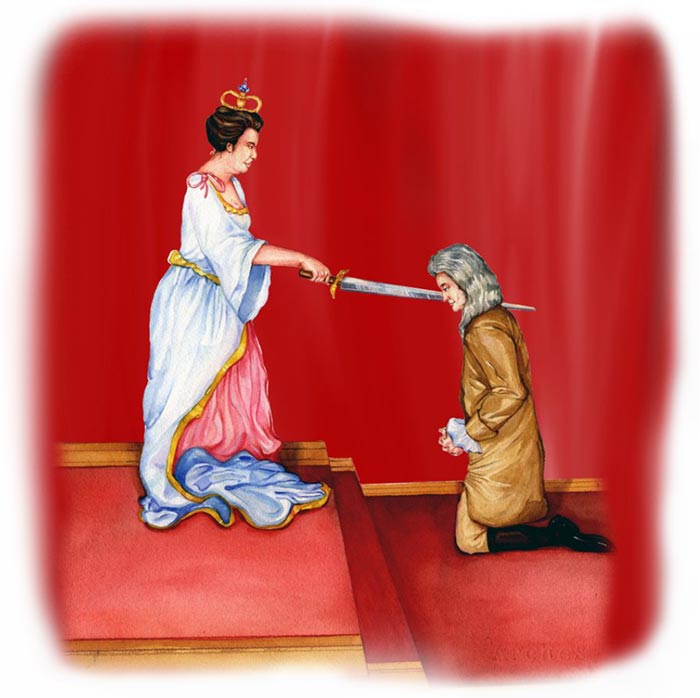
In 1705, at the age of 62, Newton was knighted by Queen Anne. Newton was the second scientist to be knighted. (First scientist to be knighted was Sir Francis Bacon in 1603). Related to the subjects of alchemy and chemistry, Newton has left a mass of manuscripts. Most of these are extracts from books, bibliographies, dictionaries and so on, but a few of them are original. Newton had began intensive experimentation in 1669, continuing till he left Cambridge, seeking to unravel the meaning that he hoped was hidden in alchemical obscurity and mysticism. He believed that God had created the nature and structure of all matter, formed from the solid, massy, hard, impenetrable, movable particles. Most importantly, in the book 'Queries' appended to Opticks and in the essay 'On the Nature of Acids', Newton published an incomplete theory of chemical force, concealing his exploration of the alchemists, which only became known a century after his death. Newton explained a wide range of previously unrelated phenomena: the eccentric orbits of comets, the tides and their variations, the precession of the Earth's axis and motion of the Moon as perturbed by the gravity of the Sun. But his postulate of an invisible force able to act over vast distances led to him being criticized for introducing 'occult agencies' into science. Occult literary means “knowledge of the hidden” and eschatology is defined as “The department of theological science concerned with the four last things: death, judgment, heaven, and hell.” In the context of mysticism, the phrase refers metaphorically to the end of ordinary reality and reunion with the Divine.
Newton wrote many works that would now be classified as occult studies. These occult works explored chronology, alchemy and Biblical interpretation. Newton's scientific work may have been of lesser personal importance to him, as he placed emphasis on rediscovering the occult wisdom of the ancients. In this sense, some have commented that the common reference of ‘Newtonian Worldview’ as being purely mechanistic is somewhat inaccurate. Later, in the second edition of The Principia (1713), Newton firmly rejected such criticisms, saying, “it was enough that the phenomena implied a gravitational attraction, as they did; but they did not so far indicate its cause, and it was both unnecessary and improper to frame hypothesis of things that were not implied by the phenomena.”
With The Principia, Newton became internationally recognized. Even then, the continental scientists certainly did not accept the idea of action at a distance and continued to believe in Descartes vortex theory where forces work through contact. Although the laws of motion and universal gravitation became Newton's best-known discoveries, it is reported that because of his religious views which did not match with the Roman Catholics, he warned against using them to view the universe as a mere machine, as if akin to a great clock. He said, "Gravity explains the motions of the planets, but it cannot explain who set the planets in motion. God governs all things and knows all that is or can be done."
Newton's religious views were different from that of the Roman Catholics. He saw God as the master creator whose existence could not be denied in the face of the grandeur of all creation. Although, Newton was an unorthodox Christian, he was deeply religious. He wrote more on Biblical hermeneutics and occult studies than on science and mathematics. Newton secretly rejected Trinitarianism [a Christian belief system that God exists as three persons but is actually one being. The persons are understood to exist as God the Father, God the Son (incarnate as, Jesus Christ ), and God the Holy Spirit, each of them having the one identical essence or nature], but he also feared of being accused of refusing holy orders. The full extent of Newton's unorthodoxy was recognized only in the present century; but although a critic of Trinitarian dogmas and the Council of Nicaea, he possessed a deep religious sense, venerated the Bible and accepted its account of creation.
Representing his life long study and his own perception about religion and God, Newton wrote on Judaeo-Christian Prophecy, whose decipherment was essential according to him, for the understanding of God. His book was reprinted well into the Victorian Age. Its message was that Christianity went astray in the 4th century AD, when the first Council of Nicaea propounded erroneous doctrines of the nature of Christ. In late editions of his scientific works, Newton expressed a strong sense of God's providential role in nature.
Along with his scientific fame, Newton's studies of the Bible and of the early Church Fathers were also noteworthy. Newton wrote works on textual criticism, most notably 'A Historical Account of Two Notable Corruptions of Scripture'. He placed the crucifixion of Jesus Christ at 3rd April, AD 33, which agrees with one traditionally accepted date. He also tried finding hidden messages within the Bible, but was unsuccessful. Newton believed in a rationally immanent world, but he rejected the hylozoism (the doctrine that matter is inseparable from life, which is a property of matter) implicit in Leibniz and Baruch Spinoza(Jewish Dutch philosopher). The ordered and dynamically informed universe could be understood, and must be understood, by an active reason. But Newton insisted that divine intervention would eventually be required to reform the system, due to the slow growth of instabilities. For this, Leibniz lampooned him: "God Almighty wants to wind up his watch from time to time: otherwise it would cease to move. He had not, it seems, sufficient foresight to make it a perpetual motion."
In a famous correspondence by Samuel Clarke (Newton’s follower), Newton’s post was strongly defended. A century later, French mathematician and astronomer Pierre-Simon Laplace’s work 'Celestial Mechanics' had a natural explanation for why the planet orbits do not require periodic divine intervention. Newton even owned more books on humanistic learning than on mathematics and science and all his life he studied them deeply. His unpublished 'Classical Scholia' — explanatory notes intended for use in a future edition of The Principia, reveal his knowledge of pre-Socratic philosophy. Newton sought to reconcile the Greek mythology and the Bible (considered the prime authority on the early history of mankind). In his work on chronology, Newton undertook to make Jewish and pagan dates compatible, and to fix them absolutely from an astronomical argument about the earliest constellation figures.

Last Decade of Newtons Life
As Newtonian science became increasingly accepted on the continent, especially after a general peace was restored in 1714 following the War of the Spanish Succession, around the age of 71 years, Newton became the most highly esteemed natural philosopher in Europe. With early criticism and controversies, from about 1715, Opticks established itself as a model of the interweaving of theory with quantitative experimentation. Newton also constructed a primitive form of a frictional electrostatic generator, using a glass globe (Opticks, 8th Query). In an article entitled ‘Newton, Prisms, and the 'optics' of tunable lasers’ it is indicated that Newton was the first to show a diagram using a prism as a beam expander in his book Opticks. In the same book he describes, via diagrams, the use of multiple-prism arrays. Some 278 years after Newton's discussion, multiple-prism beam expanders became central to the development of narrow-line width tunable lasers. Also, the use of these prismatic beam expanders led to the multiple-prism dispersion theory.
‘De Motu(on Motion)’, an essay written by the famous Anglo-Irish philosopher George Berkeley and published in 1721 was unsuccessfully submitted for a prize that had been offered by the Royal Academy of Sciences at Paris. Berkeley rejected Sir Isaac Newton’s “absolute space time and motion.” With this essay, Berkeley is considered to be the precursor of Ernst Mach (an Austrian physicist) and Albert Einstein.
Throughout his later life, Newton was badly in dispute with Gottfried Wilhelm Von Leibniz, as to who had invented the calculus. Given the rage that Newton had shown throughout his life when criticized, it is not surprising that he flew into an irrational temper directed against Leibniz. Newton used his position as President of the Royal Society and in this capacity he appointed an 'impartial' committee to decide whether he or Leibniz was the inventor of the calculus. He wrote the official report of the committee (although of course it did not appear under his name) which was published by the Royal Society, and he then wrote a review (again anonymously) which appeared in the Philosophical Transactions of the Royal Society.
It was also a fact that Newton's De Methodis Serierum et Fluxionum was written in 1671 but Newton failed to get it published and it did not appear in print until John Collins produced an English translation in 1736. Newton had been reluctant to publish his calculus as he feared controversy and criticism. Newton's assistant, William Whiston had seen his rage first hand. Whiston was an English mathematician who succeeded Newton as Lucasian Professor at Cambridge, but was later deprived of his chair on religious grounds. He wrote:
“Newton was one of the most fearful, cautious and suspicious temper that I ever knew.”
When Newton was asked how he had made his discoveries, he replied, “Truth is the offspring of silence and unbroken meditation.” In his later life, when asked for an assessment of his achievements, Newton replied, "I do not know what I may appear to the world; but to myself I seem to have been only like a boy playing on the seashore, and diverting myself now and then in finding a smoother pebble or prettier shell than ordinary, while the great ocean of truth lay all undiscovered before me."
Newton's last decade was passed in revising his major works, polishing his studies of ancient history and defending himself against critics, as well as carrying out his official duties as President of the Royal Society. Newton was modest, diffident and a man of simple tastes. He was angered by criticism and opposition, and harboured resentment; he was harsh towards enemies but generous to friends. In government, and at the Royal Society, he proved an able administrator. Towards the end of his life, Isaac Newton lived at Cranbury Park, near Winchester with his niece, Catherine Conduitt, and her husband John Conduitt, who was his assistant at the Royal Mint. He was one of the most famous men in Europe. His scientific discoveries were unchallenged. He had also become wealthy, investing his sizeable income wisely and bestowing ample gifts to charity. However, in his later years, a combination of pride, insecurity and side-trips on peculiar scientific inquiries led even some of his few friends to worry about his mental stability.
Newton, at the age of 84, died in his sleep on 31st March, 1727 in London. He was buried in Westminster Abbey. During his last years Newton gave away a very large part of his estate to his relatives, and hence died intestate. After his death, Newton's hair was examined and found to contain mercury, probably resulting from his alchemical pursuits. According to most scholars, Newton was a monotheist who believed in Biblical prophecies but was Anti-Trinitarian. In an age notable for its religious intolerance, there are few public expressions of Newton's radical views, most notably his refusal to receive holy orders and his refusal, on his death bed, to receive the sacrament when it was offered to him.
Newton has been regarded for almost 300 years as the founding exemplar of modern physical science, his achievements in experimental investigation being as innovative as those in mathematical research. Most of his findings are useful and are the basis of modern physical and astronomical science of today's world including the science and technology of satellites. His most famous three universal laws of motion enabled many of the advances of the Industrial Revolution which soon followed and were not to be improved upon for more than 300 years, and are still the underpinnings of the non-relativistic technologies of the modern world.
The alchemy behind Newton's mind and soul that achieved his extraordinary discoveries like never before always remains obscure, but tracing the trajectory of Newton's achievements is also very interesting.
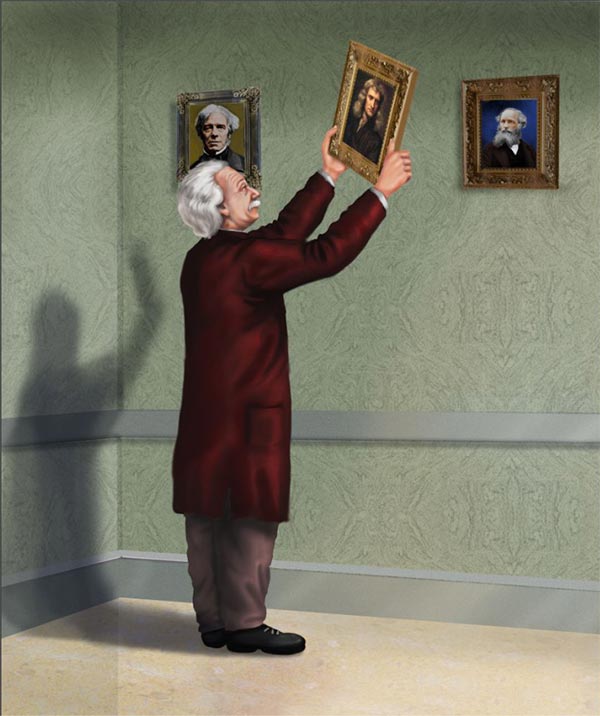
English poet Alexander Pope was moved by Newton's accomplishments to write the famous epitaph :
Nature and nature's laws lay hid in night; God said, "Let Newton be" and all was light.
Albert Einstein kept a picture of Newton on his study wall alongside ones of Michael Faraday(English scientist) and James Clerk Maxwell (Scottish mathematical Physicist). One Newton scholar remarked, “It would take another Newton to understand Newton.” While Newton lived, he was respected like God. Joseph-Louis Lagrange (French mathematician) often said, “Newton was the greatest genius who ever lived,” and once added, that Newton was also "the most fortunate, for we cannot find more than once a system of the world to establish." Indeed Newton was the greatest genius to ever live.
Next Biography






